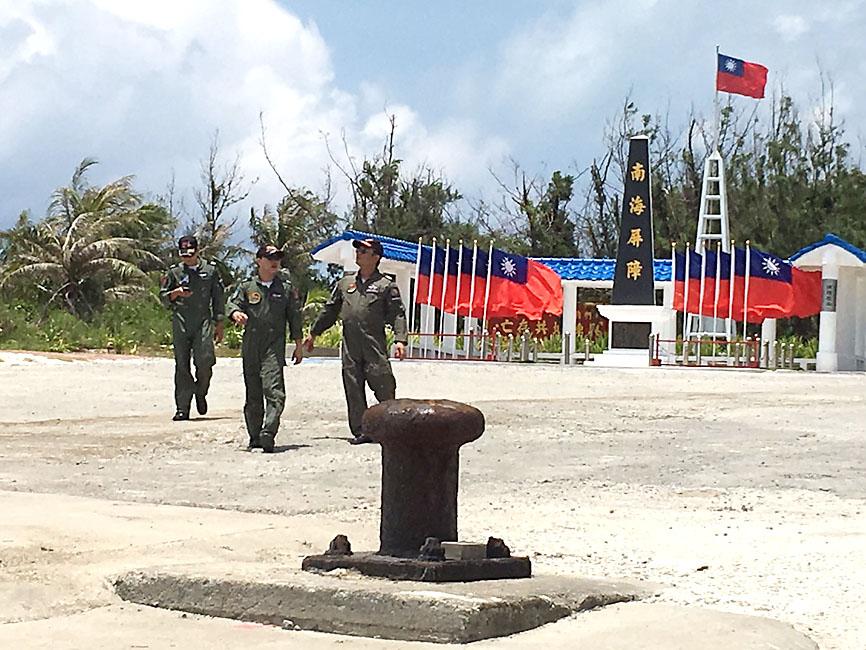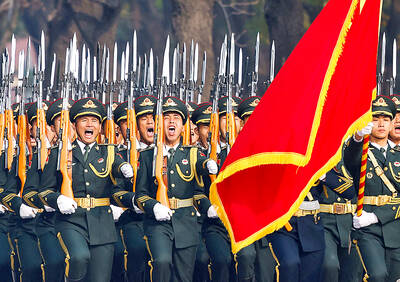The military last week sent “no small number” of Marine Corps officers to the Pratas Islands (Dongsha Island, 東沙群島) following reports of a Chinese People’s Liberation Army (PLA) drill targeting the islands scheduled for this month.
In an interview with Hong Kong’s Bauhinia Magazine published on Saturday last week, PLA National Defense University professor Li Daguang (李大光) confirmed that the Chinese army was planning to stage a simulated invasion of the Pratas Islands in the South China Sea this month.
The islands comprise three atolls, with Pratas Island, at 1.74km2, being the largest. They lie southwest of Taiwan proper in the South China Sea about 444km from the Kaohsiung Harbor.

Photo: CNA
In response, the Ministry of National Defense has stationed a large number of Marine Corps officers on Pratas Island, a source said yesterday.
A contingent of coast guard officers has also been stationed on the island as part of the ministry’s response, the source said, adding that all of the officers were dispatched from Taiwan proper.
The ministry would not comment on the deployment of officers to the island, saying only that it would “respond accordingly to changes in the situation,” while urging the public to remain calm.
Japan’s Kyodo news agency in May first reported about the PLA’s plan to stage a simulated invasion of the islands this month, but China had not confirmed the speculation until Li’s interview.
However, Li did not specify the time or specific location of the planned drill.
The islands initially had a permanently stationed contingent of marines, but the job of protecting them was given to the Coast Guard Administration in 2000.
The Marine Corps’ 99th brigade would now protect the islands jointly with the coast guard in response to the renewed PLA threat, the source said.
The stationing of officers on the island would also serve to relieve coast guard officials who have been monitoring the islands, and would allow them to return to Taiwan proper during their time off, other military sources said.

Conflict with Taiwan could leave China with “massive economic disruption, catastrophic military losses, significant social unrest, and devastating sanctions,” a US think tank said in a report released on Monday. The German Marshall Fund released a report titled If China Attacks Taiwan: The Consequences for China of “Minor Conflict” and “Major War” Scenarios. The report details the “massive” economic, military, social and international costs to China in the event of a minor conflict or major war with Taiwan, estimating that the Chinese People’s Liberation Army (PLA) could sustain losses of more than half of its active-duty ground forces, including 100,000 troops. Understanding Chinese

The Ministry of Foreign Affairs (MOFA) yesterday said it is closely monitoring developments in Venezuela, and would continue to cooperate with democratic allies and work together for regional and global security, stability, and prosperity. The remarks came after the US on Saturday launched a series of airstrikes in Venezuela and kidnapped Venezuelan President Nicolas Maduro, who was later flown to New York along with his wife. The pair face US charges related to drug trafficking and alleged cooperation with gangs designated as terrorist organizations. Maduro has denied the allegations. The ministry said that it is closely monitoring the political and economic situation

UNRELENTING: China attempted cyberattacks on Taiwan’s critical infrastructure 2.63 million times per day last year, up from 1.23 million in 2023, the NSB said China’s cyberarmy has long engaged in cyberattacks against Taiwan’s critical infrastructure, employing diverse and evolving tactics, the National Security Bureau (NSB) said yesterday, adding that cyberattacks on critical energy infrastructure last year increased 10-fold compared with the previous year. The NSB yesterday released a report titled Analysis on China’s Cyber Threats to Taiwan’s Critical Infrastructure in 2025, outlining the number of cyberattacks, major tactics and hacker groups. Taiwan’s national intelligence community identified a large number of cybersecurity incidents last year, the bureau said in a statement. China’s cyberarmy last year launched an average of 2.63 million intrusion attempts per day targeting Taiwan’s critical

AGING: As of last month, people aged 65 or older accounted for 20.06 percent of the total population and the number of couples who got married fell by 18,685 from 2024 Taiwan has surpassed South Korea as the country least willing to have children, with an annual crude birthrate of 4.62 per 1,000 people, Ministry of the Interior data showed yesterday. The nation was previously ranked the second-lowest country in terms of total fertility rate, or the average number of children a woman has in her lifetime. However, South Korea’s fertility rate began to recover from 2023, with total fertility rate rising from 0.72 and estimated to reach 0.82 to 0.85 by last year, and the crude birthrate projected at 6.7 per 1,000 people. Japan’s crude birthrate was projected to fall below six,